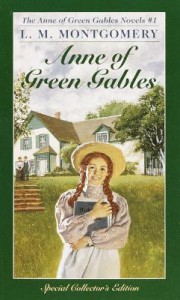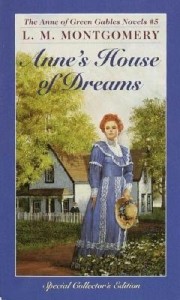A guest post by Jessica Banks. This is cross posted on Reads 4 Tweens, so if you follow both sites, it will look familiar.
This is cross posted on Reads 4 Tweens, so if you follow both sites, it will look familiar.
I came to the Anne of Green Gables series relatively late, the summer between my freshman and sophomore years of high school. I’d read the first book two or three times before that, but I got my hands on the full series just before leaving for our family’s three-week RV adventure, a summer tradition. I devoured the series as we drove for days from Wisconsin to New England, then up into Eastern Canada; my goal was to finish them by the time we reached Prince Edward Island, where the stories are set.
 Like so many millions of girls, I loved Anne’s quirkiness, her lavish affection and loyalty toward friends, the believable hijinks and mishaps, gently molding her into an admirable woman. Lucy Maud Montgomery was an important early female voice, writing about the contemporary life of young women—Rilla of Ingleside, for instance, is the only contemporarily written account of World War I from the perspective of a Canadian woman. Montgomery folded her own life story into the plots of her books, giving herself an outlet for the feelings, and her readers an authentic exploration of real emotions that’s much more complex than her books’ tween-to-teen targeting would suggest.
Like so many millions of girls, I loved Anne’s quirkiness, her lavish affection and loyalty toward friends, the believable hijinks and mishaps, gently molding her into an admirable woman. Lucy Maud Montgomery was an important early female voice, writing about the contemporary life of young women—Rilla of Ingleside, for instance, is the only contemporarily written account of World War I from the perspective of a Canadian woman. Montgomery folded her own life story into the plots of her books, giving herself an outlet for the feelings, and her readers an authentic exploration of real emotions that’s much more complex than her books’ tween-to-teen targeting would suggest.
In any series that spans the entire lifetime of a character, deaths are inevitable, especially in a pre-modern setting. We see beloved characters grow old and die, and it feels natural—sad, but not unbearably so, because it’s true to life. Only one death stands out as particularly harsh, if only because it blindsides both the characters and the reader. But, I would argue, that one death teaches young readers more about love and mortality than almost any other character death in YA literature.
In Anne’s House of Dreams, the newlyweds navigate the reconciliation of childhood  dreams with adult responsibilities. They learn that they are expecting their first child, and they are full of hope and delight. This baby is wanted; this baby is loved. But this baby comes too early, and Grace is stillborn.
dreams with adult responsibilities. They learn that they are expecting their first child, and they are full of hope and delight. This baby is wanted; this baby is loved. But this baby comes too early, and Grace is stillborn.
Anne and Gilbert are shocked that tragedy could touch them in their little cocoon of happily ever after, and the grief and depression that follow are the first real test of their marriage. Their responses aren’t overblown—it would’ve been easy to wallow in the angst. But we know these characters so well by that time that it doesn’t take much to make us feel what they feel. Montgomery herself lived through this tragedy, so she’s as gentle with us as she is with them. She gives them time to mourn and adjust to a new, harsher reality, and in so doing, she telegraphs to the reader that it’s okay that she needs time to process this development, too.
From a disturbingly early age level, books include elements of sexism and sexual violence, often in that horrid Afterschool Special kind of way. Each tragedy is clearly signaled, yet the characters are impotent to stop it. Many times, this is accomplished through the laziest of storytelling—”If only you’d told me” might as well be reduced to an acronym. The point of including these events is the same as including a death—it proves to the reader that this author is serious, that this story is as cruel and random as the world around us.
And certainly, mothers are fair game for a significant death, often for the purpose of leaving a child without the person likeliest to intercede on his behalf or insulate him from harm. And it’s not unusual for mothers in pre-modern stories to get bumped off in childbirth, almost always “off-screen,” frequently before the book even begins. Either the child to whom she’s giving birth is the main character, to tap into feelings of guilt; is a sibling, to set up bitterness and resentment; or dies along with the mother, making tidy work of the whole thing.
Anne’s House of Dreams stands out because only the child dies, leaving the main characters to struggle with the aftermath. We didn’t even have a chance to get to know the character that died, effectively summoning a reflection of Anne and Gilbert’s reactions in the reader. The next time I saw the subject handled as well—acknowledgement of the grief as dreams for the future must be retooled to accommodate this loss—was in the first 12 minutes of Pixar’s Up. Perhaps this is related to the shocking continuation of the societal taboo about discussing things like infant and maternal mortality and post-partum depression. The ice is only just beginning to break around those subjects.
Maybe this is why readers don’t warn each other in advance of this heartwrenching scene. Or perhaps it’s just late in the series, and only the die-hard Anne fans stick it out that far. But it’s the kind of thing parents should definitely be prepared to discuss with their child, because it may be the kid’s first knowledge that pregnancy is a fraught, imperfect process that can go wrong in so many different ways. That knowledge, and the awareness it engenders in young female readers, is really important, though, and doesn’t get covered in even the most liberal of sex ed courses. I’d much rather my child’s first encounter with the subject come in the form of this aching, honest, compassionate portrayal. It’s an unkind death, but one that accomplishes so much more than just turning the plot.

